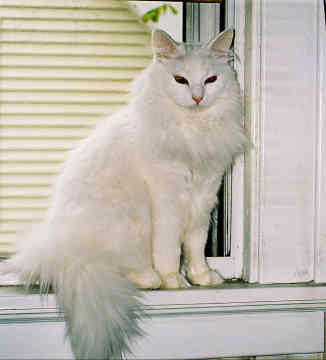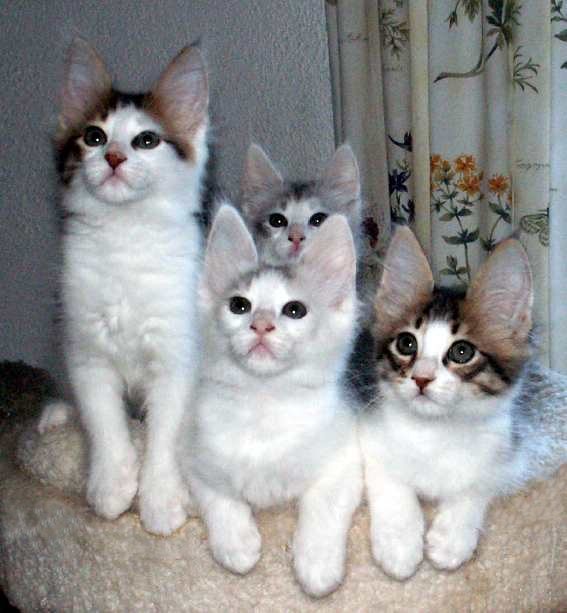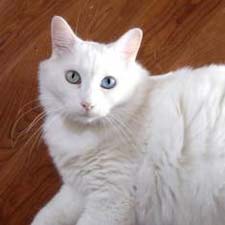



|
Turkish Angora Description
The Turkish Angora is a medium cat with a glistening and beautiful coat. The head is small to medium and in proportion to the body; medium long in length and in a smooth shaped wedge. Ears should be large, pointed and tufted, set closely together. They should be vertical and erect. Eyes should be large and almond shaped, any eye color is acceptable.
The body should be medium sized, however balance and gracefulness are more important than size. They should be long and slender, oval rather than round, fine boned with firm muscularity. Legs should be long and end in small, round and dainty paws. Tufted toes are preferable.
The coat should be single coated with no undercoat. The length may vary but the tail and ruff should be long and full, finely textured with a silk-like sheen. The back legs should have 'britches'. The Angora comes in more than 40 colors and combinations.
Turkish Angora Temperament
This is a breed that bonds completely to its family and is not happy unless it is right there in the middle of the action. They are excellent conversationalists and will never leave you hanging on for a reply. Good natured but determined, this is a breed that loves to play and can be very mischievous. A scrap of paper or a set of toes are an excellent idea for pouncing, however they dislike being cuddled and much prefer activity and movement.
Turkish Angora Care
Though a generally healthy and hearty breed, they have fallen victim to a common genetic disorder amongst cats. Those Angora's with white coats and blue eyes are born deaf. This is a disorder found in most white coated/ blue eyed felines and is not specific to this breed. Those cats that suffer from deafness should be kept indoors and can live full and healthy lives.
Turkish Angora History
No one is quite sure where the Turkish Angora originated from; the long hair gene is recessive and may have been a spontaneous mutation that occurred centuries ago in the breed and was perpetuated by the cats' inability to move out of the region. They have been in Turkey and the surrounding areas for centuries, there is even a legend of Mohammed cutting off his sleeve so as not to disturb his cat during a nap. The were formerly known as Ankara, the name of the capitol of Turkey, along with the long-haired rabbits and goats of the same name. All are prized for their long, fine hair. Turkish Angora's were imported to France and Britain as early as the 1500's and were in America by the 1700's.
As the flashier Persian grew in popularity, the Turkish Angora fell out of favor. They were extensively used in Persian breeding programs to give length and silkiness to the Persian coat. When the GCCF (Governing Council of the Cat Fancy) decided to lump all cats with long hair into one category, Persians, Russian Longhairs and Turkish Angoras were bred together indiscriminately. Outside of their home country, this breed virtually vanished.
In the early 1900’s the government of Turkey, together with the Ankara Zoo, began a meticulous breeding program that continues today. Because they are so valued by the Turkish people, it has been difficult to obtain cats to begin western breeding programs. In 1964, however, Liesa F. Grant, wife of Army Colonel Walter Grant, managed to successfully import a pair of Angora’s to America after her husbands term of duty was completed, complete with certificates of ancestry. These revived the breed and the breed received CFA registration in 1970 with Championship status in 1973 for white cats only. Other colors were permitted in 1978.
|